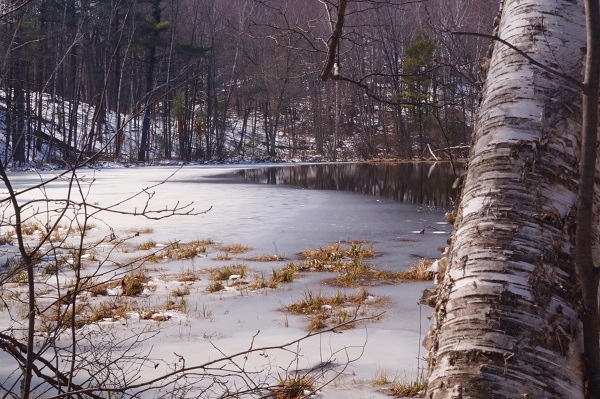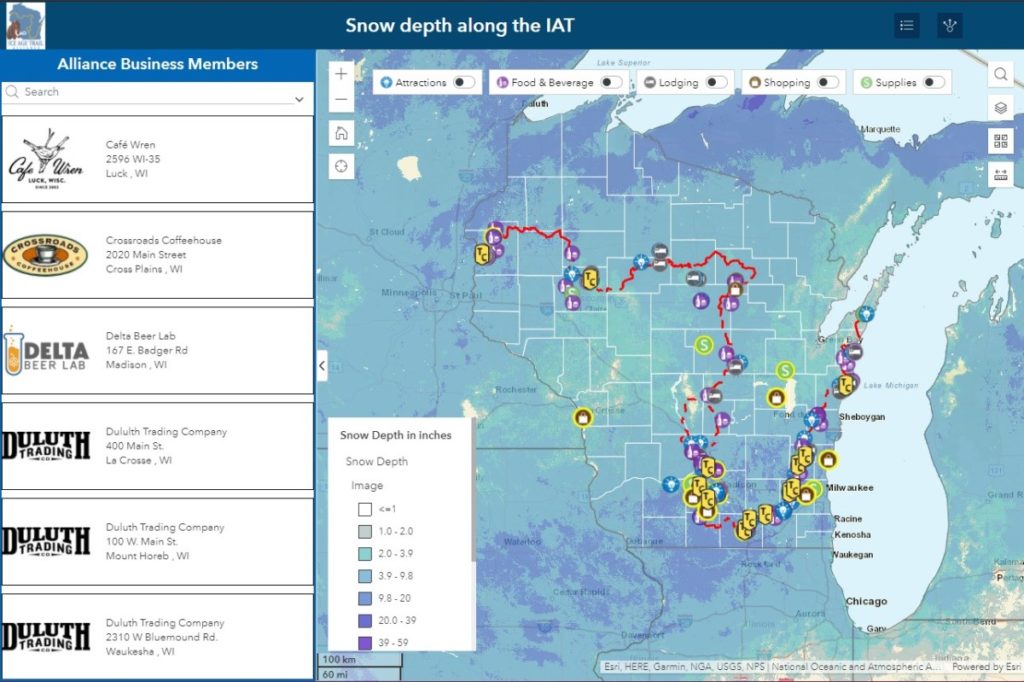Photo by Rachel Roberts
Winter Hiking on the Ice Age Trail
Cold temperatures, short days, icy trails, and potential trail closures pose challenges for the aspiring winter hiker. See our list of winter hiking tips to consider before venturing out on the Ice Age National Scenic Trail during the colder months.
Is the Ice Age Trail open in the winter?
The Ice Age National Scenic Trail remains open year round. However, there may be temporary closures and important Ice Age Trail condition reports that hikers should be aware of before setting out on a hike. If you encounter hazardous conditions or trail closures while hiking that are not reported on the Trail Alerts map, please submit a Trail Alert.
View our Trail Alerts interactive map for up-to-date Trail conditions and closures
Know where to go for snow!
Our Winter Wonderland Snow Depth Map helps you plan your snowy Ice Age Trail adventures!
7 Tips for Winter Hiking
See the list below for tips to hike safely during the colder months.
1) Plan Ahead and Start Early
When planning your hike, consider how many miles you can realistically cover in wintry conditions. Hiking in snow and ice means taking slower and more careful steps, and it lengthens the amount of time it takes to get from point A to point B. You may get tired sooner than expected or run out of daylight if the hike ends up taking too long.
Make the most of shorter daylight hours by starting earlier in the day rather than later. Plan to be off the Trail before dark to avoid getting lost or having an accident.
2) Keep an Eye on the Weather
Weather can be notoriously unpredictable from one day to the next. Check weather conditions regularly. If heavy snow or below-freezing conditions are expected and you don’t have the right gear for the weather, postpone the hike for another day. The Ice Age Trail will be there another day.
3) Bring a Friend
Hiking with a friend or a group ensures that you are not alone on the Trail if any accident occurs. As with any hike, be sure to tell someone where you are going and when you should be back.


4) Layer up!
The basic gear for layering up for in cold weather includes the following:
- Cold weather accessories:
- Insulated gloves
- Warm hat
- Neck gaiter or scarf
- Warm face mask
- A base layer: this layer is worn against the skin and should wick away sweat. Consider a polyester or wool material that retains heat but not moisture.
- A mid layer: worn over your base layer, this is your insulating layer. Often this is a fleece jacket with good insulation, and lined walking pants.
- A shell layer: this layer is worn over other clothing and protects you from wind and moisture, such as rain jacket and wind or rain pants.
- No cotton ever: cotton retains moisture and can make you cold once you perspire or become wet. Do not wear any cotton when hiking in cold temperatures.
- Wear wool socks, and bring an extra pair: thick insulating wool socks will keep your feet warm. Bring an extra pair along too in case your first pair gets wet.
5) Invest in Specialized Winter Gear
Segments of the Ice Age National Scenic Trail can become extremely icy during the winter and early spring. Snowy trails, packed down by many feet, quickly turn to ice. Conversely, you may be confronted with deep snow in less traveled parts of the Ice Age Trail.
Essential gear for winter conditions includes the following:
- Ice cleats: Winter traction devices like attachable ice cleats are an essential addition to your winter hiking repertoire. Having extra traction prevents dangerous falls on slippery trails.
- Gaiters: Hiking gaiters are made of durable, waterproof fabric and attach to your lower leg and hiking boots. They act as a barrier and keep snow from entering your hiking boots.
- Hiking boots (waterproof if possible): Don’t pack your summer trail shoes for a winter hike. Be sure to have hiking boots, preferably ankle-high, with a sturdy sole and full weatherproofing. Even if your boots aren’t already waterproof, you can treat them with a variety of waterproofing sprays.
- Hiking poles (with rubber tip removed): Hiking poles offer extra stability and can help keep you upright on an icy trail.
- Snowshoes: Snowshoes redistribute weight and help you stay on top of deep snow. The best time to strap on snowshoes is right after it snows.
- Sunglasses: On sunny winter days, the glare of sunlight on snow can be disorienting and blinding. Wearing sunglasses on winter hikes can greatly improve visibility and comfort.


6) Pack Safety Gear
There are a few basic items that every winter hiker should carry in case of emergency. Aside from basic hiking gear, you should always have:
- Trail map
- First aid kit
- Compass
- Cell phone
- Hand warming packets
- Headlamp
- Pocket knife or multi-tool
- Water bottle and high-calorie snacks
7) Stay Hydrated!
Pack water to prevent dehydration when hiking in cold weather. It may seem less critical to drink water during a wintertime hike, but you are working just as hard to maintain body temperature and hike long distances — stay hydrated! Even better, bring tea, coffee, or hot cocoa in a thermos (or make it using a small, portable camp stove) for extra warmth and hydration while hiking.
Looking for winter hike recommendations?
See Travel Wisconsin’s 11 Ice Age Trails for Winter Hiking!





